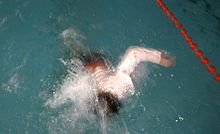Clothes swimming
As clothes swimming refers to the swimming in a conventional clothes instead of swimwear or a swimming suit . In many countries it is part of lifeguard training , military naval training or civil swimming training for the purpose of self-rescue . Occasionally it is also practiced as a leisure activity.
Physical effects
The clothing restricts the swimmer in his mobility and swimming speed very much, the clothing increases the frictional resistance of the body with the water during the swimming movement enormously. As a result, the swimmer consumes more strength and tires faster. The wider the clothing, the greater this effect.
Since the clothing has a slightly higher density than the water (e.g. wool 1.32 g / cm³, cotton 1.51 g / cm³, polyester 1.33 g / cm³), it can appeal to swimmers who are about 3% higher density than water, pull it down slightly, which it can and must compensate for with the swimming movement. The upward and downward movement of the garment in the water does not change.
When leaving the water, the clothing soaked with water has a correspondingly higher weight (sum of the weight of the fabric and the water it contains) and accordingly a high density. For this reason, crawl swimming with clothing is particularly strenuous, as the weight of the wet clothing is a high load during the arm stroke over water.
use

The swimming in clothes serves as a training method to gain stamina and speed, as well as for self-rescue.
Swimming in clothing is part of the test to acquire the life-saving badge of the German Life Rescue Society (DLRG), the ASB water rescue service and the water rescue service , as is the case with the Austrian ARGE Wasserrettung and the SLRG in Switzerland .
In the Netherlands , it is part of regular swimming training and a prerequisite for obtaining a swimming diploma .
In the Bundeswehr , according to the rules of the DLRG or the water watch, swimming in clothes is a military discipline when taking off the badge . According to the training and maintenance of individual basic skills and physical performance , all soldiers must take this discipline off.
Individual evidence
- ↑ a b Marion Theisen: Does wet clothing pull you down in the water? , wdr.de, accessed on July 11, 2019
- ↑ DLRG lifeguard badge
- ↑ Wasserwacht Bayern - Bavarian Red Cross: Training in lifeguarding
- ↑ Swimming and life-saving badges from ARGE Österreichisches Wasserrettungswesen
- ^ Brevet I of the SLRG ( Memento from January 17, 2011 in the Internet Archive )
- ↑ Nationaal Platform Zwembaden , accessed on April 28, 2015
- ↑ ( page no longer available , search in web archives: training and maintenance of individual basic skills and physical performance - PDF )
